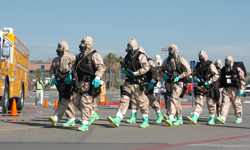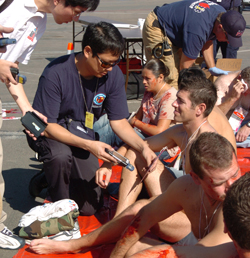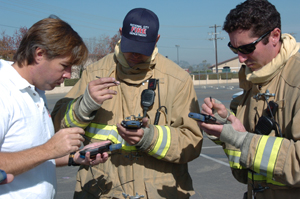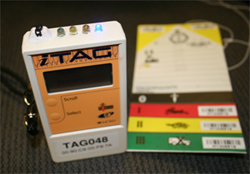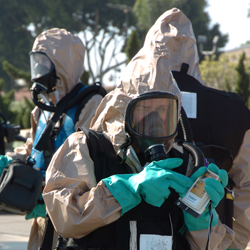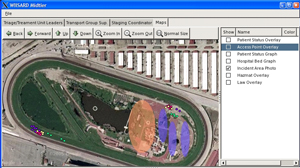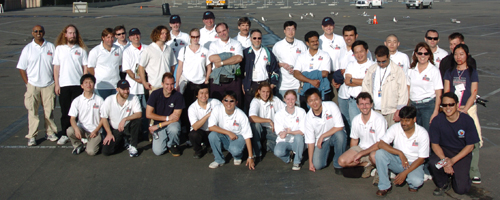UCSD Tests Intelligent Triage, Other Technologies in San Diego Disaster Drill
|
Volunteer to play the role of a "victim" in the 2006 exercise in Atkinson Hall!
WIISARD Project Empowers First Responders with High-Tech ToolsSan Diego, CA, November 21, 2005 -- In Joni Mitchell's Big Yellow Taxi, "they paved paradise and put up a parking lot." In San Diego last week, the big yellow taxi was in the parking lot -- until emergency officials detonated a car bomb that destroyed the taxi and sent plumes of charcoal-grey smoke billowing into the clear-blue sky over the Del Mar Fairgrounds.
The explosion triggered a six-hour disaster drill simulating the aftermath of a car bomb attack and accidental release of lethal chemicals. The scenario assumed 25 fatalities and 125 injured.
The drill brought together roughly 1,100 emergency officials, first responders, volunteer 'victims' and more than two dozen researchers and staff from UCSD and the California Institute for Telecommunications and Information Technology (Calit2). The university team was part of the Wireless Internet Information System for Response in Medical Disasters (WIISARD), a $4 million project funded by the National Institutes of Health's National Library of Medicine.
|
The Del Mar disaster drill was the latest and largest to be staged by San Diego's Metropolitan Medical Strike Team (MMST) as part of a three-year, $800,000 program funded by the Department of Homeland Security. For fire, police, hazardous materials, SWAT and other first responders, the goal of the joint exercise was to practice working together in a crisis environment in order to be better equipped to respond in case a real disaster strikes.
"This is the first time that WIISARD technologies have been integrated in every aspect of the medical response in a disaster drill," says MMST medical director Theodore Chan, a professor of clinical medicine at UCSD. "From initial triage tagging to transporting victims off the site, each new system or device underscored how much disaster response can benefit from new technology."
As in previous drills, WIISARD researchers deployed communications infrastructure and software systems, while putting wireless devices with new applications in the hands of first responders and victims. Users, in turn, provided feedback on how the high-tech tools performed.
|
"The biggest lesson was probably that responders took very well to the new technology," says professor of medicine Leslie Lenert, principal investigator on the WIISARD project and associate director of Calit2's UCSD Division. "So far the project has demonstrated that it is possible to capture all the necessary data. Now we need to work on ways for managers to react to that data and get the knowledge into the decision-making process."
"This was a big step for the project," agrees Jacobs School of Engineering computer science professor Bill Griswold, who is responsible for WIISARD's overall software architecture. "This was our first end-to-end test of the WIISARD concept."
|
Indeed, the drill marked the first deployment of the WIISARD system software, which has been under development for over two years. It is optimized to allow the system to continue working even if a piece of the network fails or a device disappears out of range -- so-called 'disconnected' operations that, by definition, are more likely to happen at the chaotic scene of a disaster.
According to Griswold, the client-server architecture enables operating over wireless by supporting disconnected operation in several ways. "The server software exports remote objects to client applications, so that the programmer of the client can program in familiar object-oriented terms, rather than be constantly burdened with programming for disconnected operation," explains the Computer Science and Engineering (CSE) professor. "Updates to local client objects are propagated with asynchronous events, permitting continued local operation while updates happen in the background." In addition, conflicting updates are resolved by rolling updates (events) back to the previous stable point, and then reapplying the updates.
|
Del Mar was also the first time that client devices and applications developed by UCSD researchers were deployed to run on the WIISARD software architecture. "One thing completely new was the iTAG, an 'intelligent' triage tag," said WIISARD PI Lenert. "It was successfully used to tag and track victims in the hot zone by responders in protective suits."
The iTAG is an advanced, active radio frequency (RF) identification tag designed by Calit2 principal development engineer Doug Palmer. Swathed in sand-colored Level C gear to protect them from toxic chemicals, a team of ten triage doctors and nurses checked out the wounded and put 38 of the electronic tags around the necks of victims.
"It was amazing to watch the triage team, in bunny suits, pushing a couple of buttons on the tag to record the victim's triage status," says Palmer. "Immediately one of four colored lights started flashing, and then at the command post the tag and its location showed up on a screen. Soon after, there was a light on the screen for each victim, indicating the seriousness of their condition. The system works."
|
The ID tags were a big hit with responders. "It took them only a few minutes to learn how to use the tags," recalls UCSD emergency physician Colleen Buono, who led the triage team. "And the geo-location data and wireless transmission represent a quantum leap over conventional paper triage tags. One day the devices could also carry a patient's medical history and other potentially life-saving data."
Other 'client' systems tested during the Del Mar drill included PDA hardware with a bar code scanner for triaging and treating patients; pulse-oximeters running on wireless-enabled PDAs to monitor pulse rate and blood-oxygen levels of victims; and supervisor software that runs on a ruggedized tablet PC and can be used by team leaders in the field. The software applications targeted each tier of emergency-response personnel: providers, midtier responders, and senior officials.
|
The latter application is called Command Center. "It aggregates data from many different sources onto a single display, giving comprehensive and real-time situational awareness to incident commanders needing to make timely and accurate strategic decisions," says Barry Demchak, a first-year CSE graduate student who is developing the application. "It was well received by command personnel at the drill. It's clear that there is lots of room for innovation and that the results could greatly improve the effectiveness of the dedicated professionals in the field."
|
The Command Center system is still in its infancy but a vital part of WIISARD's mission. At the command post in Del Mar, "it was clear how segregated the disciplines still are," says Steve Vandewalle, a technical specialist with the San Diego Fire Department's Hazardous Materials Response Team and part-time WIISARD advisor. "All the data needs to be collated and displayed on a large screen. If the medical, tactical, bomb and security layers are displayed on a screen in real time over the venue map, it would do much to provide a unification to joint command."
Several technologies were upgraded after the last drill in May at San Diego's Cruise Ship Terminal. Calit2 and Ericsson researchers once again provided the connectivity for emergency communications at the disaster scene. This time they deployed a mesh network of ten rather than four 802.11b access points. They created a nearly one-kilometer-long corridor of WiFi connectivity linking the command post with emergency workers throughout the affected area.
|
"The network was good at handling all of the data and services at the scene," says Rajesh Mishra, an Ericsson researcher who works at Calit2 on the Ericsson-funded Adaptive Systems project. "But when several emergency vehicles, including fire trucks, arrived on the scene and parked right next to one of our access points, it created a WiFi 'shadow' in that region -- forcing clients in that area to perform disconnected operations that are an integral part of our service design."
Other features integrated as part of the WiFi mesh network included Internet services using multiple third-generation cellular backhaul such as EVDO and WCDMA.
RealityFlythrough is another technology first shown in May. Co-developed by CSE's Griswold and Ph.D. candidate Neil McCurdy, it allows an early arrival at a disaster scene, using a helmet-mounted camera and tablet PC, to capture still images and video, which are stitched together into a 360-degree, interactive virtual tour of the scene for later arrivals or the command post.
|
"We made quite a few advances to handle unreliable networks," says McCurdy. "Rather than trying to force video across the network at live bitrates, we instead captured high-quality key images (1 per second) on the client devices (the cameras), and queued up the images for eventual delivery to the server." Live video was only transmitted to the server if the command center desired it and the network could support it. In addition, the camera units themselves were less bulky than the ones used in May.
As the disaster drill drew to an end, organizers used another WIISARD technology: the WiFi Bullhorn. The rugged, wireless notification system developed by a team of four electrical engineering seniors in ECE 191 this quarter was funded by Calit2. "They built the loudspeaker-bullhorn system to be deployed in crisis situations to manage crowds and first responders," says Calit2's Doug Palmer, who is advising the ECE 191 students. "They set up the WiFi Bullhorn in a crowded area, and then remotely, through laptop computers, sent recorded or stock messages to the unit for broadcast." The first system was ready in time for the Del Mar drill, and the San Diego Fire Department's chief information officer used it to conclude the drill. [Listen] [Real player required]
Officials from the funding agency, the National Library of Medicine, who attended the disaster drill were clearly impressed. "It was gratifying to see first hand what has been accomplished with the WIISARD project over the first two of its three-year National Library of Medicine contract," observes Richard Banvard, NLM's project officer for WIISARD. "Watching the dedication and enthusiasm of the WIISARD staff during the Del Mar drill made obvious the catalyst behind the successes of the project to date. We at the NLM anticipate a rousing success by the end of the contract period."
|
Related Links
WIISARD
NIH National Library of Medicine
MMST
May 2005 WIISARD Disaster Drill News Release
ECE 191 WiFi Bullhorn Project
WIISARD Image Gallery
Volunteer to play the role of a "victim" in the 2006 exercise in Atkinson Hall!


